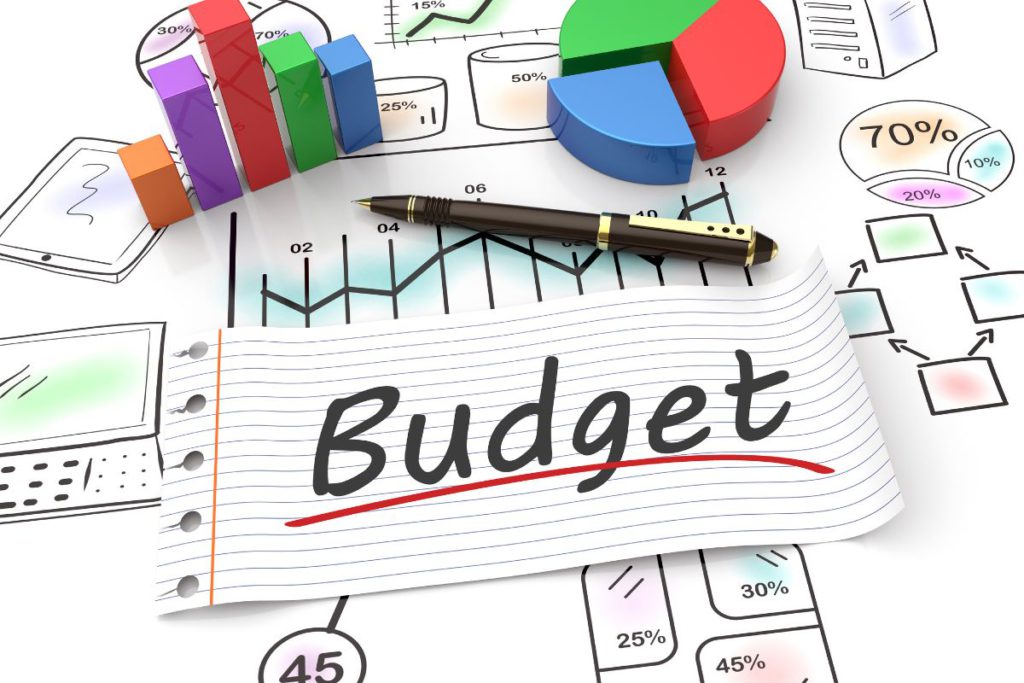Do you want to know where your money disappears each month? Do you find yourself living paycheck to paycheck despite earning a decent income?

If so, you’re not alone.
But here’s the good news: creating a budget can be your financial superhero, diving in to save your wallet and peace of mind.
In this guide, we’ll walk through five simple steps to create your first budget – and, more importantly, how to stick to it like glue.
Why Budgeting Matters (And Why You Shouldn’t Run Away Screaming)
Before we start, let’s address the elephant in the room.
The word “budget” often triggers a fight-or-flight response in many people. It gathers images of restrictive spending, joyless living, and saying goodbye to all things fun.
But here’s a secret: a reasonable budget isn’t about poverty but empowerment.
Imagine knowing exactly where every dollar goes, being able to save for that dream vacation without guilt, and never again feeling the cold sweat of upcoming bill payments.
That’s the power of a well-crafted budget. It’s not about limiting your life but expanding your possibilities.
Now that we’ve reframed budgeting as your financial best friend, let’s get started!
Step 1: Track Your Spending

The 30-Day Money Diary Challenge
If you accept it (and trust me, you should), your first mission is to become a financial detective.
For 30 days, track every penny that leaves your wallet or bank account. Yes, even that $2 coffee counts!
Here’s how to make it happen:
Choose Your Weapon: Decide on a tracking method. You can go old-school with a notebook and pen or adopt the digital age with budgeting apps like Mint, YNAB, or even a simple spreadsheet.
Be Ruthlessly Honest: Record everything. Does that urge buy at the checkout? Log in. The subscription you just remembered? Write it down. Your financial future depends on your honesty here.
Categorize Like a Pro: Group your expenses into categories. Common ones include housing, transportation, food, entertainment, and utilities.
But feel free to get creative – “Stress-Busting Retail Therapy” could be a category if it reflects your spending habits!
Make It a Habit: Set reminders on your phone to log expenses daily. The key is consistency.
The Eye-Opening Moment
At the end of 30 days, prepare yourself for what I like to call the “Where Did All My Money Go?!” revelation.
This moment of truth can be shocking, enlightening, and sometimes a bit uncomfortable. But remember, knowledge is power. You’re not here to judge yourself but to understand and improve.
Step 2: Set Your Financial GPS – Define Your Goals

Now that you clearly understand your spending habits, it’s time to dream a little. Where do you want your money to take you?
Short-Term vs. Long-Term Goals
- Short-Term Goals (within the next year):
- Build an emergency fund.
- Pay off a credit card.
- Save for a weekend getaway.
- Long-Term Goals (beyond one year):
- Save for a down payment on a house.
- Retirement plan.
- Fund your child’s education.
The SMART Goal Framework
To turn your financial dreams into reality, use the SMART framework:
- Specific: “Save money” is unclear, while “Save $5,000 for an emergency fund” is specific.
- Measurable: How will you track progress? In dollars? In percentage of income saved?
- Achievable: Be ambitious but realistic. Saving 90% of your income might not be feasible, but 15% could be.
- Relevant: Does this goal align with your values and long-term vision?
- Time-bound: Set a deadline. “Save $5,000 for an emergency fund by December 31st” gives you a clear target.
Write down your SMART goals and place them somewhere visible. These will be your north star as you navigate your budgeting journey.
Step 3: Design Your Budget Blueprint

Now comes the fun part (yes, fun!). It’s time to create your budget blueprint.
Think of this as designing your dream home, but instead of rooms, we’re allocating money to different aspects of your life.
The 50/30/20 Rule: A Solid Foundation
One popular budgeting framework is the 50/30/20 rule. Here’s how it breaks down:
- 50% for Needs: This covers rent/mortgage, utilities, groceries, and minimum debt payments.
- 30% for Wants: Your fun money! This includes dining out, entertainment, hobbies, and those little luxuries that make life enjoyable.
- 20% for Savings and Debt Repayment: This chunk goes towards your financial goals, like building that emergency fund, investing for retirement, or aggressively paying down debt.
Customizing Your Blueprint
While the 50/30/20 rule is a great starting point, your budget should reflect your unique situation. Here’s how to tailor it:
- List Your Income: Start with your take-home pay. Include any regular side hustles or passive income streams.
- List Your Expenses: Refer back to your 30-day tracking. Categorize each expense as a need, want, or savings/debt repayment.
- Compare to the 50/30/20 Rule: How does your current spending align? Don’t panic if it’s way off – that’s why we’re here!
- Adjust and Prioritize: If you’re overspending in one area, look for places to cut back. Remember those goals you set? Let them guide your decisions.
- Plan for Irregular Expenses: Don’t forget about those non-monthly costs like car insurance or holiday gifts. Divide the annual cost by 12 and set aside that amount each month.
The Secret Sauce: Flexibility
Here’s a nugget of wisdom: The perfect budget doesn’t exist. Life happens, priorities shift, and unexpected expenses pop up. The key is to build flexibility into your budget. Maybe it’s a small “miscellaneous” category or a slight buffer in each category. This flexibility will help you stick to your budget long-term without feeling restricted.
Step 4: Automate Your Way to Success

Now that you have your budget blueprint, it’s time to put it on autopilot. Automation is your secret weapon against forgetfulness, temptation, and the “I’ll do it later” syndrome.
Set It and (Almost) Forget It
- Direct Deposit Splitting: Ask your employer to split your paycheck. For example, you can automatically deposit 20% into your savings account.
- Automatic Bill Pay: Set up automatic payments for fixed expenses like rent, utilities, and subscriptions. This ensures you always make all payments and avoid late fees.
- Scheduled Transfers: Set up automatic transfers to your savings accounts on payday. Pay yourself first!
- Use Round-Up Apps: Apps like Acorns or Chime round up your purchases to the nearest dollar and invest the difference. It’s like a digital change jar on steroids.
The Power of Pay-Yourself-First
You’re adopting the “pay-yourself-first” philosophy by automating your savings and bill payments. This means prioritizing your financial goals before discretionary spending. When savings happen automatically, you’re less likely to spend that money elsewhere.
Step 5: Stay on Track – Monitor, Adjust, and Celebrate

Congratulations! You’ve created your budget. But remember, a budget is a living document that needs regular check-ups and occasional adjustments to stay healthy.
The Weekly Check-In
Schedule a weekly “money date” with yourself (or your partner if you’re budgeting together). This is your time to:
- Review Your Transactions: Make sure everything is categorized correctly, and there are no surprises.
- Check Your Progress: How close are you to your savings goals? Are any categories overspent?
- Plan for the Week Ahead: Are any significant expenses coming up? How can you prepare?
The Monthly Deep Dive
At the end of each month:
- Compare Actual vs. Planned: How well did you stick to your budget categories?
- Identify Patterns: Are there areas where you consistently overspend or underspend?
- Adjust as Needed: You may need to allocate more to groceries and less to dining out. That’s okay! Your budget should work for you, not against you.
Celebrate Your Wins!
Did you stick to your budget this month? Celebrate! Have you reached a savings milestone? Do a happy dance! Acknowledging your progress, no matter how small, is crucial for long-term motivation.
Consider setting up a reward system. For example, if you meet your budget goals for three months straight, treat yourself to something special (within budget).
The Road Ahead: Your Budgeting Journey
Creating and sticking to a budget is a journey, not a destination. There will be bumps along the way, unexpected detours, and a few U-turns. But with each step, you’re building powerful financial habits that will serve you for a lifetime.
Remember:
- Progress Over Perfection: Wait to nail it. Each month you stick to your budget is a win.
- Stay Flexible: Life changes, and your budget should, too. Regular adjustments are a sign of a healthy financial plan.
- Keep Learning: The world of personal finance is vast. Keep educating yourself through books, podcasts, and reputable financial websites.
As you start this budgeting adventure, remember why you started. Financial freedom, peace of mind, and the ability to say “yes” to the things that truly matter to you—that’s what budgeting is all about.
So, are you ready to take control of your financial future? Your journey to budgeting success starts now, and in the future, you will thank yourself for taking this crucial first step.
Happy budgeting!

